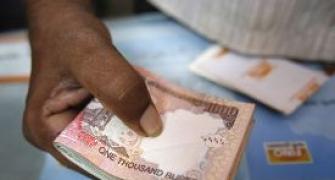There are clear cracks in the case for short-term bullishness on India -- but the longer term still looks hopeful, rues Akash Prakash
I think over the coming few months, India bulls are going to have their conviction severely tested.
Markets are likely to go down, correct and stay subdued for some time.
At every market decline, holders of Indian equities will be forced to re-examine why they are invested in the country and what the case for the investment was.
If we look at the bull case for India as outlined just 12 months back, there are clear cracks in the thesis.
The economy has shown no real signs of acceleration and is stuck in the 7-7.5 per cent range (going by the new gross domestic product, or GDP, series).
Even in the coming year, growth will remain broadly at similar levels.
There is no sign of the growth acceleration many (including me) were expecting by now, even though we are already 12 months into the new government’s tenure.
Catalysing an economic recovery is proving more difficult than most thought.
Private-sector capital expenditure remains in a funk, torpedoed by a combination of bust balance sheets, no risk appetite or capital with the majority of the banks and little improvement in end demand.
Simply trying to unclog projects has not been enough to unlock investment.
Power, metals and public-private partnerships were the drivers of the last corporate capex cycle.
Each of these sectors is today embroiled in policy or global business cycle issues.
They will neither bounce back quickly, nor lead the next investment cycle.
Despite an initial surge in corporate confidence, entrepreneurs still do not feel comfortable putting money into investment.
Not enough change has happened at the ground level, little progress has been made in improving the ease of doing business or simplifying our web of rules and regulations.
We all know that without an improvement in corporate capex, growth acceleration and job creation to the extent we wish is just not possible.
While inflation has declined, the Reserve Bank of India has been slower to cut rates than most had expected.
After raising rates initially, Governor Raghuram Rajan has been slow to reverse course.
Despite a halving of oil prices, an economy that remains very weak and the Wholesale Price Index-based inflation in negative territory, he seems to be in no hurry.
Given his desire to maintain 150-200 basis points real interest rates and a forecast of near six per cent inflation by 2015-16, the scope to cut does look limited.
Can he do another 50 basis points?
Yes.
But more than that -- the 100-150 basis points some bulls were cheering for -- looks very unlikely.
Earnings have also been much weaker than we had expected.
This financial year, 2014-15, will end with earnings growth below six per cent, and the fourth quarter will have seen no growth at all.
The wave of earnings downgrades continues unabated.
The visibility for 2015-16 earnings is also murky at best.
The biggest disappointment for most investors has been on the reform front.
The approach has been mostly incrementalism, with very little out-of-the-box thinking or desire to break the mould.
The hope for root-and-branch reform that fundamentally changes the way government functions and takes decisions now seems only a forlorn hope.
The building blocks for a structural improvement in productivity do not seem to be in place.
The political discourse still seems to be that encouraging business equates to you being anti-farmer or anti-poor.
The government is having to defend itself for trying to improve the business environment.
The difficulty in trying to push for reform and change a governance framework as calcified as ours has been under-estimated .
This whole minimum alternate tax issue for foreign institutional investors is another big blow to investor perception.
Without getting into the merits of the case, it is clear that India and the government have lost the perception battle.
Perhaps unfairly, most investors sitting overseas are convinced that the government is acting in an arbitrary and illogical fashion, and that India is once again back to doing funny stuff on taxes.
Having rebuilt India’s credibility with investors slowly and painfully over the last 12 months, it is unfortunate that the government has been unable to present its point of view to the global media or communicate the reasons behind its inability to change course.
And the difficulty with badly written laws and uneven interpretation persists across sectors, not just for tax.
While we have had the disappointments outlined above, markets have been on a strong run.
Investors have been willing to give us the benefit of the doubt as they had very limited alternative options.
Valuations are not inexpensive on near-term numbers, with markets trading at 18-19 times earnings.
We remain among the most expensive emerging markets.
Most foreigners are very overweight on India, an investment stance that worked in 2014. However in 2015, India has begun to underperform, while China has been on a roll.
With most investors underweight on the country, China’s surge is hurting money managers’ performance.
India is no longer the only game in town.
In China, one can deploy large pools of capital, the government seems to be writing a put on the market, valuations are not yet over the top and momentum is very strong.
It is only a matter of time before money moves, and the India overweight reduces among global emerging market as well as regional managers. The pain associated with remaining short on China is just too much.
India is also poised to see a surge in issuance from both the government and companies.
Thankfully, domestic flows into equities remain strong and are a powerful counterbalance to any foreign outflows.
While the short term looks tough, I still like the longer-term outlook.
Economic growth will accelerate, rates and inflation will decline, governance and productivity improvements are being put in place and a long-term secular shift of domestic savings into financial assets is underway.
It is all just taking longer than we thought.
There remain enough low-hanging fruit, that even incremental reform and centralised, more cohesive decision-making are enough to deliver the growth targets needed.
It is also a fact that earnings are significantly below trend.
Simple regression to mean in profit margins over the coming few years will deliver near 20 per cent earnings growth.
Adjusted for this growth, return on capital metrics and expected decline in interest rates, valuations do not look challenged.
Thus, India seems poised to go through a period of consolidation, with markets at best staying put -- but more likely continuing to correct.
This corrective phase, to my mind, will be a buying opportunity, but your conviction will get tested.
With the markets underperforming, earnings disappointing and perceptions on reform weakening, one will need to keep an eye on the long term and the big picture.
Be prepared to once again defend why you want to invest in India.
Akash Prakash is at Amansa Capital. These views are his own










